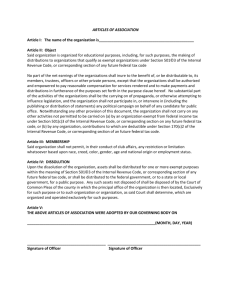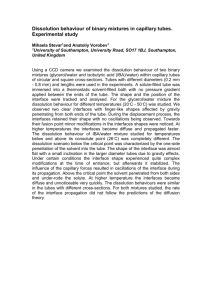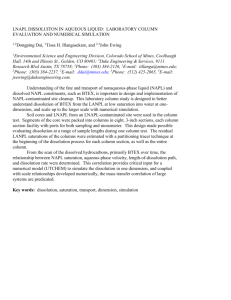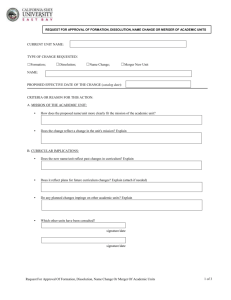Checklist for Dissolving Your Business What is a corporate
advertisement
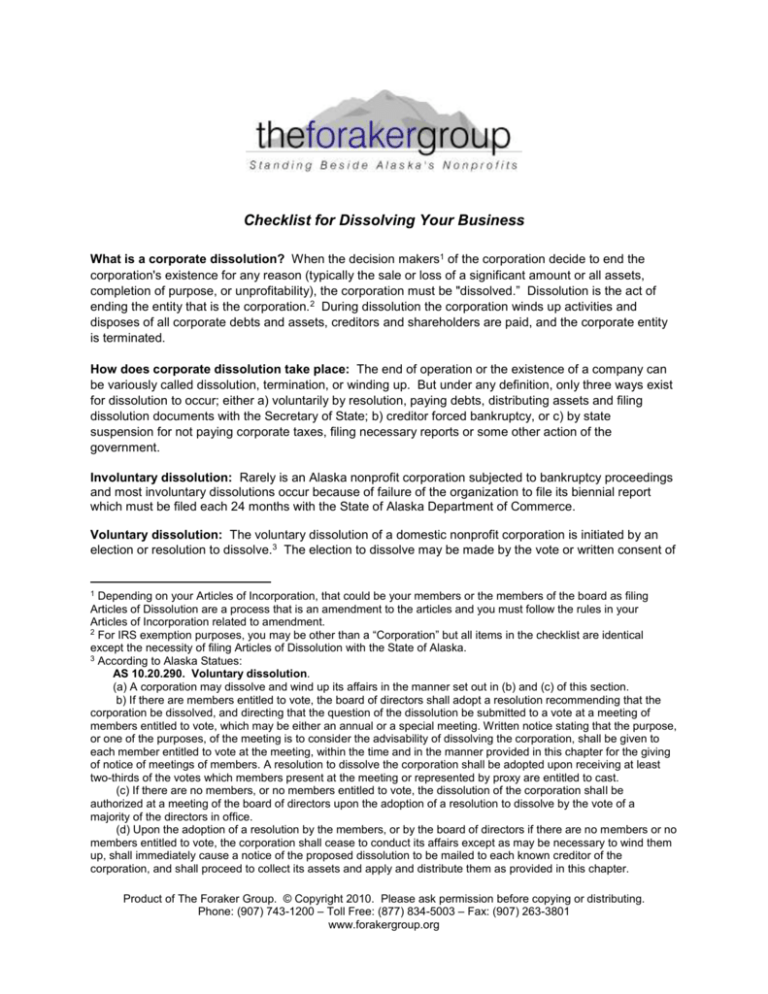
Checklist for Dissolving Your Business What is a corporate dissolution? When the decision makers1 of the corporation decide to end the corporation's existence for any reason (typically the sale or loss of a significant amount or all assets, completion of purpose, or unprofitability), the corporation must be "dissolved.” Dissolution is the act of ending the entity that is the corporation.2 During dissolution the corporation winds up activities and disposes of all corporate debts and assets, creditors and shareholders are paid, and the corporate entity is terminated. How does corporate dissolution take place: The end of operation or the existence of a company can be variously called dissolution, termination, or winding up. But under any definition, only three ways exist for dissolution to occur; either a) voluntarily by resolution, paying debts, distributing assets and filing dissolution documents with the Secretary of State; b) creditor forced bankruptcy, or c) by state suspension for not paying corporate taxes, filing necessary reports or some other action of the government. Involuntary dissolution: Rarely is an Alaska nonprofit corporation subjected to bankruptcy proceedings and most involuntary dissolutions occur because of failure of the organization to file its biennial report which must be filed each 24 months with the State of Alaska Department of Commerce. Voluntary dissolution: The voluntary dissolution of a domestic nonprofit corporation is initiated by an election or resolution to dissolve.3 The election to dissolve may be made by the vote or written consent of 1 Depending on your Articles of Incorporation, that could be your members or the members of the board as filing Articles of Dissolution are a process that is an amendment to the articles and you must follow the rules in your Articles of Incorporation related to amendment. 2 For IRS exemption purposes, you may be other than a “Corporation” but all items in the checklist are identical except the necessity of filing Articles of Dissolution with the State of Alaska. 3 According to Alaska Statues: AS 10.20.290. Voluntary dissolution. (a) A corporation may dissolve and wind up its affairs in the manner set out in (b) and (c) of this section. b) If there are members entitled to vote, the board of directors shall adopt a resolution recommending that the corporation be dissolved, and directing that the question of the dissolution be submitted to a vote at a meeting of members entitled to vote, which may be either an annual or a special meeting. Written notice stating that the purpose, or one of the purposes, of the meeting is to consider the advisability of dissolving the corporation, shall be given to each member entitled to vote at the meeting, within the time and in the manner provided in this chapter for the giving of notice of meetings of members. A resolution to dissolve the corporation shall be adopted upon receiving at least two-thirds of the votes which members present at the meeting or represented by proxy are entitled to cast. (c) If there are no members, or no members entitled to vote, the dissolution of the corporation shall be authorized at a meeting of the board of directors upon the adoption of a resolution to dissolve by the vote of a majority of the directors in office. (d) Upon the adoption of a resolution by the members, or by the board of directors if there are no members or no members entitled to vote, the corporation shall cease to conduct its affairs except as may be necessary to wind them up, shall immediately cause a notice of the proposed dissolution to be mailed to each known creditor of the corporation, and shall proceed to collect its assets and apply and distribute them as provided in this chapter. Product of The Foraker Group. © Copyright 2010. Please ask permission before copying or distributing. Phone: (907) 743-1200 – Toll Free: (877) 834-5003 – Fax: (907) 263-3801 www.forakergroup.org a majority of all the members of the corporation or, if there are no members, by the board of directors as required in the Articles of Incorporation of the entity. After resolution, certain actions and activities are required of the board to ensure a legal end to the corporate entity without personal liability falling on board members. Organized Plan of Dissolution: Whatever the form of your business, you will need to follow an organized plan for closing your doors. Your plan, in Alaska called a Plan of Distribution, will have to follow guidelines set forth in Alaska statutes, the Internal Revenue Code, and state and local tax authority regulations. The following checklist is adopted from the Model Business Corporation Act and is specific to corporations. Not all corporations or organizations will be required to follow every procedure and the list is developed for Alaska corporations. Consequently, it is a good idea to hire an attorney for assistance. 1. Whether or not your decision to wind up operations is motivated by financial difficulties, take the time to speak to your accountant or bookkeeper and understand your assets and debts. 2. Develop a Plan of Distribution to pay debts and distribute any surplus. 3. Consult your Articles of Incorporation and determine the member or board vote necessary for a proper election or resolution to dissolve the corporation and adopt the Plan of Distribution along with Article of Dissolution as required by Alaska law. Alaska law requires that the votes be recorded and reported in the Articles of Dissolution. 4. Act to file Plan of Distribution and the necessary Articles of Dissolution with the Alaska Department of Commerce.4 5. Cancel state and/or municipal permits and licenses, including your seller's permit, business license and fictitious (“dba”) or assumed business name. 6. Cancel your real estate and other leases and insurance policies. Give your landlord the required notice stated in your lease, or negotiate closure. 7. Collect outstanding accounts receivable (before you notify customers you're going out of business). 8. Notify your employees and plan to pay them their last paychecks within the amount of time required by state law, and as required, the value of accrued, unused vacation days as well. 9. Notify your customers and fulfill any contractual obligations, as soon as possible, or negotiate others taking over your obligations. Cancel any orders or purchase requests. Return any deposits or payments for goods not delivered or services not rendered. 10. File and close all grant reports. Closure statements from funders is a good practice to ensure you do not have undisclosed creditors based on nonperformance under a grant awarded prior to dissolution. 11. If you're sitting on saleable inventory, consider a "going out of business" sale or otherwise dispose your inventories for value. 12. Make your final federal and state payroll deposits (penalties for failure to timely file are exceptionally high and are personal to board members). (e) Following the adoption of a resolution to dissolve, a copy of it executed by the corporation's president or vicepresident and a secretary or assistant secretary shall be immediately filed with the commissioner. The resolution must state the number of members and the number of directors voting for and against it. (f) A corporation, which has filed a resolution of voluntary dissolution, which has not concluded its affairs and received a certificate of dissolution, within two years after the date of filing the resolution, shall be involuntarily dissolved by the commissioner. 4 http://www.commerce.state.ak.us/ Product of The Foraker Group. © Copyright 2010. Please ask permission before copying or distributing. Phone: (907) 743-1200 – Toll Free: (877) 834-5003 – Fax: (907) 263-3801 www.forakergroup.org 13. Submit final sales tax forms and funds due up to the closeout date – incidental sales of goods are not normally subject to sales taxes. However, sales of inventory, even at fire sale prices, are subject to tax. 14. Formally notify your creditors: suppliers, lenders, service providers and utilities. 15. Settle or pay all of your business debts – money owed to your landlord, bank, suppliers, utilities, and service providers after the removal of all assets that are subject to retention of title arrangements, fixed security, or are otherwise subject to proprietary claims of others. Generally, the priority of claims on the company's assets will be determined in the following order: 5 1. First, the costs of any liquidation of assets are met out of the company's remaining assets. 2. Second, the preferential creditors and those holding security interests under applicable law are paid. 3. Third, in many legal systems, the claims of the holders of a floating charge will be paid; other claims may also fit into this layer. 4. Fourth, if there is anything left, the unsecured creditors are paid out pari passu in accordance with their claims. In many jurisdictions, a portion of the assets which would otherwise be caught by a floating charge are reserved for the unsecured creditors. 5. Last, any remaining assets should be distributed as determined by the board of directors to a 501(c)(3) exempt organization in accord with the dissolution provisions of your Articles of Incorporation. Unclaimed assets will usually vest in the state. 16. Ask for letters from creditors indicating that your bills are paid in full as you pay off each creditor. 17. Cancel your business credit cards. 18. Have your accountant prepare a final accounting for the filing of your necessary reports and returns with the federal, state and local governments. 19. Pay your accountants and attorneys as necessary. 20. Close your business bank account. 21. File your final employment-related tax returns: IRS Form 940 – reporting withholding for the last quarter, 5 According to Alaska Statutes AS 10.20.295 Distribution of assets. The assets of a corporation in the process of dissolution shall be applied and distributed as follows: (1) all liabilities and obligations of the corporation shall be paid and discharged, or adequate provision shall be made therefor; (2) assets held by the corporation upon condition requiring return, transfer or conveyance, which condition occurs by reason of the dissolution, shall be returned, transferred or conveyed in accordance with the requirements; (3) assets received and held by the corporation subject to limitations permitting their use only for charitable, religious, eleemosynary, benevolent, educational or similar purposes, but not held upon a condition requiring return, transfer or conveyance by reason of the dissolution, shall be transferred or conveyed to one or more domestic or foreign corporations, societies or organizations engaged in activities substantially similar to those of the dissolving corporation, under a plan of distribution adopted as provided in this chapter; (4) other assets, if any, shall be distributed in accordance with the provisions of the articles of incorporation or bylaws to the extent that the articles of incorporation or bylaws determine the distributive rights of members, or any class or classes of members, or provide for distribution to others; (5) any remaining assets may be distributed to persons, societies, organizations or domestic or foreign corporations, whether for profit or nonprofit, as may be specified in a plan of distribution adopted as provided in this chapter. Product of The Foraker Group. © Copyright 2010. Please ask permission before copying or distributing. Phone: (907) 743-1200 – Toll Free: (877) 834-5003 – Fax: (907) 263-3801 www.forakergroup.org IRS Form 941 – reporting wage withholding for the last quarter, IRS Form W2 – for all employees reporting their wages and tax withheld, IRS Form W3 – summarizing W2 information IRS Forms 1099 Misc – for any vendor paid in excess of $600 during the period, State tax withholding and wage reporting forms. 22. File your final tax returns, checking the box stating that this is your final return. Tax-exempt organizations must file Forms 990 at the end their operations, either through shutting down, transferring their assets or merging with another tax-exempt organization and must inform the IRS about the details of the action. For organizations other than private foundations, this is done by filing a final Form 990, 990-EZ or e-Postcard (990-N). It is possible that a Form 990-T will also be necessary if the organization has generated unrelated business income. Which of these forms the organization files depends largely on its gross receipts and assets. After you’ve indicated on the 990 or 990-EZ that you are terminating your organization or transferring assets, you’ll need to file a Schedule N, Liquidation, Termination, Dissolution, or Significant Disposition of Assets. The information required on Schedule N includes a description of the assets and any transaction fees, the date of distribution, the fair market value of the assets and information about the recipients of the assets. IRS Publication 4779 describes all necessary filings. The final report should be filed with: Attn: EO Entity, Mail Stop 6273, Ogden, UT 84201. 23. If you sell business assets, file IRS Form 4797, Sales of Business Property or, if you sell the bulk of your business assets to one buyer, file IRS Form 8594, Asset Acquisition Statement. 24. Upon the filing of the Articles of Dissolution to the Secretary of State a Certificate of Dissolution will be issued and the corporation will be completely dissolved and its corporate existence will cease. 25. Leave contact information with former business contacts, colleagues and employees. If your organization is faced with dissolution, it is always advisable to contact an attorney conversant in corporate and dissolution process. As the laws, both federal and state, change periodically, the checklist attached is not intended as legal advice and should be used for information purposes only (current to January 1, 2010). Disclaimer The content and documents on this site have been prepared by The Foraker Group as an informational service and is not intended to constitute legal advice. Nothing on this website or associated pages, documents, comments, examples, answers, e-mails, articles or other communications should be taken as legal advice for any individual case or situation. The Foraker Group recommends that you seek accounting or legal advice and consult an attorney experienced in nonprofit law for any significant or specific issues facing your organization. Product of The Foraker Group. © Copyright 2010. Please ask permission before copying or distributing. Phone: (907) 743-1200 – Toll Free: (877) 834-5003 – Fax: (907) 263-3801 www.forakergroup.org

